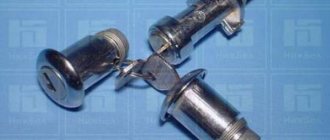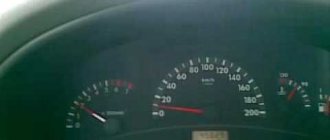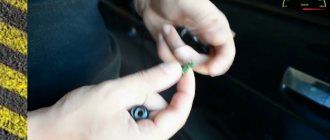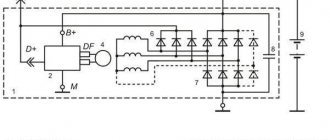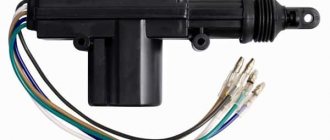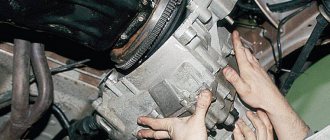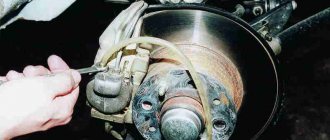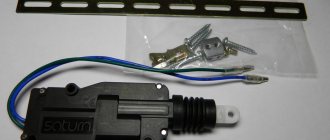You begin to appreciate many things after they are gone. The same applies to the additional options of the VAZ 2110. Central locking (CL), for example, you can not notice as long as it works properly or you can do without it altogether. But you quickly get used to good things, don’t you? Therefore, when something that provides us with a comfortable ride fails, you immediately begin to rush around in search of answers “how to fix it.”
Central locking device VAZ 2110
VAZ cars are not least good for their high maintainability. Whenever something happens to your iron horse, you can almost certainly solve the problem yourself without the help of specialists at a service station. “Ten” was no exception in this regard.
As for the central locking system specifically on Lada 110 cars, this is really a rich topic for discussion. Ignorance of elementary circuits and the operating principle of the unit can confuse many motorists. However, servicing the mechanism is quite simple. And given the enviable frequency of its failure, it turns out that knowing “how” is simply vital.
Features of the VAZ central lock
Everyone knows that the Lada models listed here use central locking controlled by negative polarity. This literally means the following: we apply “0 Volt” to one wire - all locks close. We apply the same voltage to the other wire (second) - they unlock. This is done in many European cars. What does it mean to “supply “0 Volt”? This means connecting the wire to ground.
The central locking control unit has the following wiring:
- Black wire – ground (connected all the time);
- Pink – power supply “+12V” (built-in fuse is used);
- Yellow, red - connected to the actuators in the doors (these wires are not connected to the signaling system!);
- Brown, white - control wires, just those that have already been mentioned.
Let's look at the central locking connection diagram, which is implemented “from the factory”:
First, we may decide that the triangular connector (labeled “C”) is suitable for our purposes, since it contains control contacts. But please note that the standard circuit uses a microswitch located in the driver's door. We will break two wires coming from this switch, and the relays built into the alarm unit will be connected to the breaks. Other options are excluded.
Device
The central locking system consists of several main devices that must be operational in order for the system to work correctly according to its principle.
- The main thing in this system is the control unit. It is the control unit that supplies all the signals to the actuators that perform the assigned tasks.
- The actuators, as already mentioned, perform the tasks that the control unit assigns to them.
- The third important component of the system is the sensor system. Sensors send signals to the control unit, and the control unit sends signals to the actuators.
When the driver gets into the car and turns on the power (ignition), the car will automatically lock. This is necessary to prevent the doors from opening while moving. There are systems where the car will not be able to move while they are open. During an accident, the central locking system recognizes that a collision has occurred and automatically opens the doors.
Let's make the alarm system and central locking together
Any modern alarm unit is equipped with two relays connected to the central locking control unit. One relay is opening, the second is locking, and the circuit in the general case looks like this:
In our case, the green and white cords coming from the signaling unit will be required, as indicated in the diagram. However, they will not be the only ones needed. We will connect the relay contacts to breaks in the standard wiring. This means there will be not 2, but 4 cords.
Connection diagram for VAZ central locker
Take another look at the diagram published in the first chapter. We will connect the relay to the gap in the white and brown wires going from the microswitch to the central lock control unit. And it is obvious that it is easier to break these wires near the 8-pin connector. The same one shown at the beginning.
Typical problems and their solutions
Electronic anti-theft systems of a car are subject to breakdowns and various types of malfunctions. In some cases, technical problems that arise can be resolved independently.
First of all, due to incorrect placement of additional shock and volume sensors, they may malfunction, and the alarm will go off without obvious reasons. An alarm that constantly goes off when the car owner is absent for a long time can completely discharge the battery and deprive the owner of the opportunity to start the engine. To eliminate this problem, it is recommended to check the correct placement and connection of the shock and volume sensors and, if necessary, reconnect them in accordance with the rules. Replace faulty sensors.
The alarm may not work correctly due to a large amount of interference interfering with the operation of the remote control. There are several solutions to solve this problem:
- Each time, bring the control panel as close as possible to the alarm unit or press the desired button several times.
- Reboot the alarm several times. To do this, just remove the power cable from the battery terminal for a few minutes, put it on and repeat the procedure 2-3 times.
- If possible, change the permanent parking location of the car, away from sources of interference.
If the anti-theft system does not respond to commands from the remote control, you should start troubleshooting the possible problem with the key fob. If commands from the key fob are well received up close, but do not work from a long distance, it means that the internal battery on the remote control has run out. You can replace it yourself.
Many remote controls have a battery charge indicator. If there is no such indicator, it is recommended to start fixing the problem by replacing the battery or charging the key fob.
If the remote control does not function with a fully charged battery, you need to check the alarm operation using a spare remote control. It is possible that the remote control itself is faulty. If the spare key fob controls the anti-theft system well, then it is recommended to replace the main one.
In cases where independent actions do not help to establish the operation of the anti-theft system, it is recommended to contact the service department.
This review discusses how to connect an alarm system to the central locking of the following cars: VAZ-21099, as well as 2110 and 2115. There are three standard connection schemes: for central locking controlled by negative polarity, positive and variable. But different cars have their own nuances. Sometimes it is necessary to add a fuse to the “+12 Volt” wire, sometimes, on the contrary, this is not required. VAZ locks, in turn, belong to the simplest type, the first. But the standard scheme published on the Internet is not suitable for them.
Installation of the VAZ-2110 lock actuator
You begin to appreciate many things after they are gone. The same applies to the additional options of the VAZ 2110. Central locking (CL), for example, you can not notice as long as it works properly or you can do without it altogether. But you quickly get used to good things, don’t you? Therefore, when something that provides us with a comfortable ride fails, you immediately begin to rush around in search of answers “how to fix it.”
Central locking device VAZ 2110
VAZ cars are not least good for their high maintainability. Whenever something happens to your iron horse, you can almost certainly solve the problem yourself without the help of specialists at a service station. “Ten” was no exception in this regard.
The main causes of central locking failures
If the central locking of the VAZ-2110 does not work, the reason for this is some defect in the actuators - gearmotors. In the entire structure, they are the most vulnerable point, since they are subject to the greatest load. These devices move during operation, which speeds up the production of the elements included in their design.
But there is one important detail - VAZ-2110 cars were discontinued more than ten years ago, which already suggests that any of the cars will have problems associated with the “obsolescence” of elements. The wiring is destroyed, gear motors become unusable, even transistors in the control unit can fail over such a period due to frequent overheating. Therefore, it is necessary to carefully study all the symptoms of breakdowns and methods for eliminating them.
What is the central locking on the VAZ 2110?
The purpose of this type of device is to centrally control the automatic mechanism for opening and closing all doors in the car at once. This is especially convenient for working in conjunction with an alarm system and when operating a car in general. However, the reliability of the operation of the central locking system should definitely be checked every time by moving the handles of all four doors before going about your business for a long time, since the actuator can often fail and one of the doors may remain unlocked.
Structurally, the VAZ 2110 central lock consists of the following elements:
- electronic transistor control unit;
- gearmotor actuators, also known as activators (one for each door);
- a limit switch that determines the current state of the door (open or closed);
- electrical wiring and other installation elements.
Central locking diagram for VAZ 2110
Repair features
As a rule, in the event of a central locking malfunction, experienced electricians first check the condition of the sensors. If the central locking system is connected to the anti-theft system, then it is this system that is checked first. As stated above, activators most often fail, so they should also be checked.
If a certain door refuses to work, the reason must be found in it. This could be the solenoid itself or the wires. During the operation of the car and the frequent opening and closing of doors, a break in the wiring circuit may occur due to kinking and mechanical breakdown of the wire itself. If this is the case, then the wire needs to be replaced or the broken parts reconnected, and then insulated.
Sorry, there are no surveys available at this time.
Why the central locking on the VAZ 2110 does not work correctly
The problem of improper operation of the actuator is not at all uncommon for cars in the domestic automobile industry. Despite the fact that there are a number of reasons for the failure of mechanism parts, the principle of operation of the automatic door closing system is quite simple, and the malfunctions are very typical in their entirety. This means that any motorist can deal with them.
You don’t have to grab your head and run to the workshop in search of a qualified specialist. Thanks to the diagnostic recommendations below, you yourself are very likely to become one. If, for some reason, you don’t want to get your hands dirty, at least no one else will dare to mess with you. And this, you see, also costs a lot.
Signs of trouble
The occurrence of any malfunction in the operation of the central car lock instantly manifests itself in the form of a violation of its functionality. In this case, the signs or symptoms of a breakdown correspond to what exactly happened to the system. Therefore, problems can be identified by the following nuances:
- it is not possible to open the car using the key fob;
- opening does not work when using the key;
- the key fob does not lock the car;
- the key or button does not work when closing the door;
- one of the doors does not open or does not open;
- The central locking is triggered, closes everything, but immediately opens without a corresponding command from the driver;
- locking and unlocking work spontaneously.
We can say that malfunctions manifest themselves in the form of incorrect operation of the system. The central locking system is a complex device that consists of a large number of components and control units. This is a whole network of electrical wires, which sometimes covers the entire car. Given the complexity of the system, consideration should be given to who will carry out the repairs. It is often recommended to entrust this to specialists. At the same time, every motorist has the right and opportunity to know what malfunctions occur with the central locking, what is their cause and how they can be dealt with. Whether to repair it yourself or trust the experts is a purely individual question.
Problems in the operation of the activator electric drive
The central locking actuator is quite fragile and does not tolerate overload. The activator body, made of plastic, can easily melt if the frequency of door closing is excessively high. The duration of the control pulse also plays an equally important role. Try to always remember about the extreme fragility of the activator and not to load it during operation.
It is easy to guess that the activator is located in each individual door of the car. If the body of one of them melts due to overheating of the electric drive commutator, this becomes the cause of many problems:
- the activator on individual doors stops functioning;
- Constant overloads in a jammed electric drive cause the fuse to fail.
The actuator mechanism is entirely made of plastic. Gears can easily wear out and break during operation, or melt when the commutator overheats. As a result, when the central locking operates, characteristic creaking sounds are heard - a sure sign of imminent failure of the activators. Likewise, if the gearbox of the mechanism is humming, but the doors do not open or close.
Malfunctions of this kind can also be associated with all sorts of defects in the gearmotor and its traction. If you have recently replaced your central locking system, the reason may be that it was installed incorrectly. The mechanism may also be incorrectly adjusted or the fastening may be damaged. In any case, the door trim should be removed and checked visually.
Causes of activator failures
Almost all activator components are made of plastic. It is quite durable and can withstand heavy loads. But there are also defects and lock malfunctions. In the latter case, there is a sharp increase in the load on the motor, the gears can break down and become disengaged. The lock will buzz, but the flags will not go down (or up, depending on the current state).
But such a manifestation of breakdowns can also be caused by incorrect installation. This is only the case if work has taken place relatively recently, directly or indirectly affecting the elements of the central lock. Failure to adjust the rods is the first sign that the entire system will not work correctly. The lock on which the adjustment is incorrect will not work, while the others function properly.
Problem in the operation of the central locking electrical circuit on VAZ cars
The first possible problem follows smoothly from those mentioned in the previous section. Overload in the operation of activators leads to an increase in the operating current in the supply circuit above the rated value. As a result, the fuse blows and the central locking of the VAZ 2110 simply “dies”.
It is by checking the fuse that the diagnosis of central locking malfunctions begins. By the way, it is located in a very specific place and it is not easy to find it right away even if you know where to look. In order to get to it, you will need to fold back the central panel with the fuses and dig into the entire wiring harness in the niche that opens behind it. The “comrade” you need is packaged in a special plastic cup and connected to the pink wire.
Breakdowns in the wiring
The next important element of the entire system is electrical wiring. The operation of the central lock depends on its condition. If there are abrasions on the wires or cuts, this will inevitably lead to either spontaneous activation of the activators or to their inoperability. Most often, the wiring is destroyed at the bends - between the door and the body. To check the integrity, you need to test each wire separately. Just remember to turn off the power, otherwise you will damage the multimeter.
Problem with the operation of the VAZ-2110 central locking control unit
Electronics, of course, are reliable things. Modern control modules for the central locking VAZ 2110 are assembled using a transistor control circuit. This eliminates their mechanical wear. The shelf life of key components is measured in tens of years. The control unit is located under the plastic dashboard cover on the right side of the driver's seat.
However, power transistors can easily fail when the activators are overloaded and the collector is short-circuited. It may even happen that the signal from the control unit will constantly be sent to the lock drive if the transistor is broken. Otherwise, it will simply not turn on.
Checking the control unit is extremely simple. The voltage from the negative terminal of the battery, or directly from the pink wire supplying the control unit, is supplied to the contacts of the gearmotor (activator) in series to the red and yellow conductors. All of the above contacts can be found directly on the eight-pin connector of the control unit.
Thanks for subscribing!
Also, the control unit may issue erroneous control commands due to incorrect operation of the limit sensor. Being a mechanical device, the main door switch can simply wear out. As a result, the control unit simply will not be able to function correctly, since it will not know in what position the car doors are currently located, whether the driver's door lock is closed or open.
Principle of operation
The central car lock consists of:
- central electronic unit;
- electronic units for front and rear doors (not always present);
- driver's door electronic unit;
- push-button switches for all doors;
- limit switches for closing windows and doors;
- control units and window lift drives.
In most cases, the units responsible for controlling the power windows are directly connected to the central locking and combined into a single system. When the doors are closed, the central locking checks the condition of all doors and windows so that they are not left open when closing and activating the alarm. The central locking system cannot be considered a separate element of the car. This is the name of all system components responsible for locking the locks in the vehicle. The task is to simultaneously open and close doors, raise and lower windows, and sometimes also be responsible for opening the fuel tank lid.
The principle of operation is based on the fact that when you turn the key in the driver's side door lock, a microswitch is activated, which is responsible for the locking process. From it a signal goes to the door control unit, and then to the central unit. From there, control signals are distributed to each of the available control blocks. This allows you to simultaneously close all doors, windows, etc. When you turn the key again, the reverse process occurs, that is, unlocking. Depending on the type of device, the central locking system can be triggered by contact or non-contact methods. The second option involves using a special button on the car keys.
How well do central locking and alarm systems work together in VAZ-2110 cars?
As you know, a modern alarm system involves autonomous control of all opening parts of the car. For this reason, it is possible to connect the VAZ 2110 central locking system to the alarm system. The connection diagram for the signaling device is included in the operating instructions for the device. The central locking control circuit also seems to have an additional unused connector for this purpose.
However, in reality it is not so simple. Control signals from the alarm system to the central locking system will conflict with the information received from the limit switch installed in the driver's door. For this reason, the standard central locking control circuit with which VAZ 2110 cars are supplied from the factory should be slightly altered.
The essence of the modification is extremely simple. According to the circuit diagram, the limit switch is connected to the eight-pin connector of the central locking control unit via two wires: brown and white. These wires from the unit should be disconnected.
Now the limit switch will be connected to the alarm control circuit, and the alarm will set control signals to the electronic unit of the central locking. Perhaps the diagram described “on fingers” may seem somewhat incomprehensible to you. But it will be very easy to understand the above by studying the diagram proposed below.
Central lock VAZ 2110
To better understand the idea of connecting an alarm, it is still worth studying the instructions included with it. Thanks to this, you will have a clear idea of how to implement this idea in practice. But the essence of the connection will remain the same. The work requires minimal effort and is generally very simple.
Possible malfunctions of the locking system
If you need to find out how to find the main control unit with your own hands, then first of all you need to read the service book - it should indicate where the mechanism is located. As a rule, the unit is located under the center console, sometimes it can be hidden in the door itself. It's no secret that any device cannot work forever and over time, malfunctions may also appear in the operation of the central locking system. In practice, the device can often stop functioning due to the fact that the driver, using the remote control, transmits an extended or rapid signal to open or close the doors.
Installation of electric door lock drives
On VAZ 2110 family vehicles, the manufacturer can install a door lock system. It simultaneously locks all doors when the left front door is locked with the key, as well as when the left front door lock button is pressed. Thus, this locking system is a so-called “central locking”, which in its factory version does not allow the car doors to be unlocked and locked remotely. The capabilities of electronic alarm systems allow you to remotely control the door locks and, if you are going to install one of these systems on your car, this function can be easily implemented. If your car does not have a factory locking system (this is the most common configuration option), then in addition to the alarm system you will have to install electric locking drives. The electric locking drive is a gearmotor that combines a DC electric motor with excitation from permanent magnets and a gearbox with a rack-and-pinion type engagement. Geared motors are installed in the car doors, and their rods are connected to the lock lock rods.
The gearmotor is usually sold together with a set of parts necessary for its installation. The kit includes: a mounting plate, a set of fasteners and a coupling (for connecting the gearmotor rod with the lock lock rod), as well as the gearmotor rod.
Installation details
Very often, even the so-called silent locks (which are usually installed instead of old, noisy ones) are further modified.
There are several methods, but it is important to install a gasket between the body and the mechanism, since there remains a gap that affects the penetration of air, dust, and also the volume of sound. If it suddenly turns out that after installation the door does not latch, you can solve the problem in several ways:
If it suddenly turns out that after installation the door does not latch, you can solve the problem in several ways:
- Strengthening the lower springs (better suited for an old, noisy mechanism);
- Installing a cube of foam rubber in place of the bullet spring;
- By installing one large spring from below.
Main components
The central lock (VAZ-2110) has the following components in its design:
- Semiconductor control unit for electric drives.
- Geared motors act as actuators (there are 4 of them in total - for each there is one lock, if there is a drive for unlocking the trunk, then 5). These are small electric motors with gearboxes on the rotors.
- Limit switch that allows you to determine the state of the lock (installed in the gear motor mounted in the driver's door).
- Wires, connections, fuse.
The central locking VAZ-2110 operates in several modes:
- All locks are activated when the driver's door .
- When arming and disarming a car alarm. In circumstances where the alarm and central locking control units have been connected.
- If there is a function for remote control of the central locking from the key fob. Such accounting (software) controls have a fairly low price and are used on cars without alarms.
Replacing the lock cylinder, if there is a practical need for it
VAZ 2110 door lock cylinders
It is necessary to objectively understand that removing the door trim of the car interior is a prerequisite for replacing the car lock cylinder. Often, and in almost the absolute majority of cases, it is necessary to repair or change a car lock as a result of an attempted theft.
A complete algorithm for replacing the lock cylinder with a detailed description
So:
- first you need to very carefully remove the door trim;
- then, using a suitable screwdriver, unscrew the three mounting screws that hold the car door handle on the inside;
Lock cylinders for VAZ 2110
- now you need to disconnect the rod and the car door handle;
- after which, you must again use a screwdriver and release the lock switch from the rod;
- now, it’s time to release the lock cylinder from the bracket using a screwdriver;
Repair of lock cylinders for VAZ 2110
- if all of the above technical manipulations were completed successfully, then removing the car lock from the doorway will not be a practical task;
- now you need to unfasten the door handle, which is located outside, from the rod;
- then, using a figure-eight screwdriver, unscrew the two fastening nuts, which are located on the inside;
- after which, you just need to remove the car door handle;
Replacing door lock cylinders for VAZ 2110
- the time has come to start fixing the lock externally, having first removed the internal one, and for this you will need to unscrew two screws from the outside;
- as soon as the two external fastening screws are unscrewed, it will be practically possible to disconnect the internal component of the lock from the corresponding rod;
- now there are no obstacles left to completely remove the traction;
- after removing the lock rod, it is necessary to remove the rod that controls the shutdown button; to do this, you need to carefully remove the retaining plastic clamp;
- to remove the internal drive rod, you must first remove the stopper washer;
- the door pillar contains a lock latch adjuster, guided by its position;
- the lock regulator must be carefully and efficiently adjusted; to do this, you must first unscrew the three corresponding fastening nuts using a specialized Phillips-shaped screwdriver;
- now there is a practical opportunity to carry out the appropriate adjustment, upon completion of which it is necessary to tighten all the fastening nuts to their original position;
- in order to remove the latch, it will be necessary to unscrew the corresponding screw that holds the latch;
- after which, the screw itself must be removed;
- in the end, there are exactly two bolts left that hold the latch (they need to be unscrewed);
- the final stage is the direct removal of the lock retainer from the door pillar;
- Assembly is carried out strictly in reverse order.
Replacing a lock cylinder is a simple technical manipulation, however, it contains many nuances. Photos and videos - materials will help you understand all the nuances. The DIY replacement instructions are multi-step, but simple in terms of practical application. The cost of replacing the lock cylinder is low, but if you go to a car service center, they will most likely change the entire lock, citing the fact that there was no other way out. Although in fact the goal of such an action is extremely simple and is to increase the repair budget. In any case, by performing the replacement yourself, the car owner does not lose anything, because in case of failure, the opportunity to contact a car service always exists.
Reasons for replacing the lock cylinder
Blocking of the internal or external mechanism occurs due to improper operation, burglary or severe frost. Prerequisites for the device to break soon: creaking, difficulty turning the key, the rod has difficulty entering/exiting the core. At such moments, the larva can be saved if you go through it: apply lubricant to individual elements and remove contaminants.
For VAZ 2110, replacing the driver's door lock cylinder will be required when:
- climatic changes;
- failure of the locking ring;
- pin falling out;
- violation of the integrity of the thrust cap;
- wear of columns or teeth.
If individual fragments malfunction, they begin to cling to each other, blocking the rotation function. In winter, moisture often gets into the core and freezes. Because of this, the key turns with difficulty, jams the unlocking mechanism, or becomes blocked. Repairs have to be carried out from the passenger compartment and entered into the car through the back door.
When to change the lock
So, the need to replace the standard factory lock with a modified one arises in the following cases:
If you suspect that someone tried to steal your car. As a rule, inexperienced car thieves can only damage the lock, as evidenced by the following signs: • The front door lock began to dangle, which was not the case before; • The key turns with difficulty, naturally, the doors are not easy to open; • There is visually noticeable damage in the lock area and/or near it; • You cannot open the front door at all with your own key;
You have lost your keys. Even if you have a spare set, this fact should alert you. Maybe the keys were not lost at all, but stolen, and now car theft is a real danger. In this situation (as well as in the case of the “inexplicable” loss of house keys), for most, a replacement is an indispensable condition for sleeping peacefully. By the way, in such a situation, perhaps only the larva will be replaced, which is cheaper and less work. The cylinder is the internal door mechanism, which is actually turned with a key. It is as individual and unique as the key itself. Thus, without disassembling the entire mechanism (which is discussed below), you can carry out this small repair in order to have a completely new lock for opening the front door;
Accidentally, mechanically, you broke something in the front door lock mechanism
For example, changing the upholstery, making careless adjustments, etc. After all, the design of the lock is such that it is not limited to only the visible part, but has locking parts directly under the door trim; You want to make the lock more reliable by increasing its protective properties, for which you carry out repairs and modifications.
